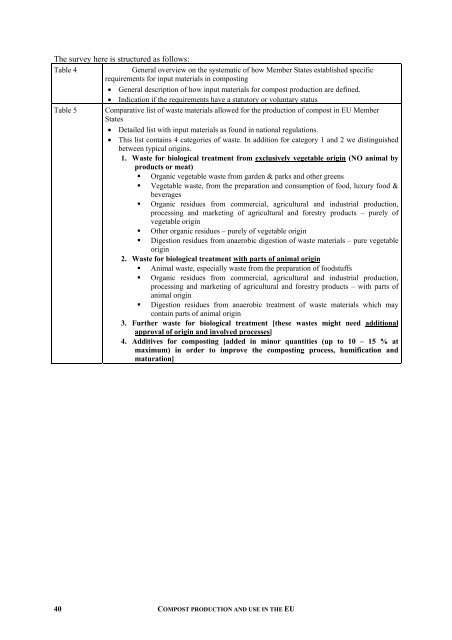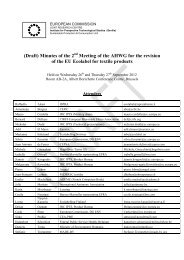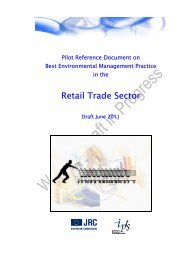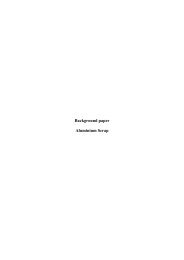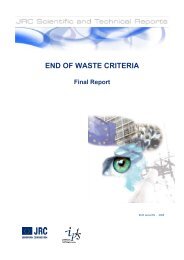final report - JRC IPTS - Sustainable Production and Consumption ...
final report - JRC IPTS - Sustainable Production and Consumption ...
final report - JRC IPTS - Sustainable Production and Consumption ...
You also want an ePaper? Increase the reach of your titles
YUMPU automatically turns print PDFs into web optimized ePapers that Google loves.
The survey here is structured as follows:<br />
Table 4 General overview on the systematic of how Member States established specific<br />
requirements for input materials in composting<br />
• General description of how input materials for compost production are defined.<br />
• Indication if the requirements have a statutory or voluntary status<br />
Table 5 Comparative list of waste materials allowed for the production of compost in EU Member<br />
States<br />
• Detailed list with input materials as found in national regulations.<br />
• This list contains 4 categories of waste. In addition for category 1 <strong>and</strong> 2 we distinguished<br />
between typical origins.<br />
1. Waste for biological treatment from exclusively vegetable origin (NO animal by<br />
products or meat)<br />
� Organic vegetable waste from garden & parks <strong>and</strong> other greens<br />
� Vegetable waste, from the preparation <strong>and</strong> consumption of food, luxury food &<br />
beverages<br />
� Organic residues from commercial, agricultural <strong>and</strong> industrial production,<br />
processing <strong>and</strong> marketing of agricultural <strong>and</strong> forestry products – purely of<br />
vegetable origin<br />
� Other organic residues – purely of vegetable origin<br />
� Digestion residues from anaerobic digestion of waste materials – pure vegetable<br />
origin<br />
2. Waste for biological treatment with parts of animal origin<br />
� Animal waste, especially waste from the preparation of foodstuffs<br />
� Organic residues from commercial, agricultural <strong>and</strong> industrial production,<br />
processing <strong>and</strong> marketing of agricultural <strong>and</strong> forestry products – with parts of<br />
animal origin<br />
� Digestion residues from anaerobic treatment of waste materials which may<br />
contain parts of animal origin<br />
3. Further waste for biological treatment [these wastes might need additional<br />
approval of origin <strong>and</strong> involved processes]<br />
4. Additives for composting [added in minor quantities (up to 10 – 15 % at<br />
maximum) in order to improve the composting process, humification <strong>and</strong><br />
maturation]<br />
40<br />
COMPOST PRODUCTION AND USE IN THE EU


